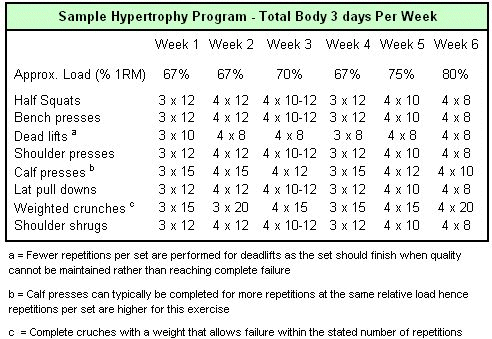These sample weight training programs are designed to develop increased muscle mass and lean weight.
The enlargement of muscle size is known as hypertrophy and is the predominant aim of bodybuilding.
While bodybuilding may still dominate many sport-specific strength training programs, in reality it is only suitable for a small number of athletes and should only make up a portion of the overall conditioning program. See the sport specific approach to strength training article to see how these sample hypertrophy weight training programs are incorporated into the annual plan.
Athletes that can benefit from a phase of hypertrophy training include shot putters, rugby players, heavyweight wrestlers and linemen in football. For these individuals, an increase in active fat-free mass is beneficial. Other athletes such as boxers and wrestlers may want to move up a weight class and can use a bodybuilding approach to do so.
Traditional bodybuilding aims to increase the size of every muscle group making it a time consuming and enervating pursuit. Hypertrophy training for sport on the other hand aims only to increase the size of the prime movers, saving time and energy for other modes of training.
While these hypertrophy weight training programs increase muscle and mass, they do not result in the nervous system adaptations that occur with maximal strength training - such as increased recruitment of fast twitch fibers and better synchronization of the muscles involved in the action.
To this end, a phase of hypertrophy training should be followed by a phase of maximal strength training before finally being converted into sport-specific power or muscular endurance. The table below is an example of how this may occur for a collegiate-level football lineman:

Designing Hypertrophy Weight Training Programs
Hypertrophy training employs moderate to heavy loads and moderate to high volume. It is generally accepted that higher volume is required to sufficiently overload the muscles to bring about substantial increases in fibre size. However, as mentioned earlier the athlete's overall training program must be taken into account - so a smaller number of exercises is used compared to traditional bodybuilding. Each session should consist of no more than 6 - 9 exercises focusing on the prime movers for 3-6 sets per exercise.
Loads should be in the 67% - 85% one repetition maximum (1RM) range so that failure in each set occurs between 6 - 12 repetitions. Sets must be performed to failure. The cumulative effect of exhaustion stimulates chemical reactions and protein metabolism so that optimal muscle growth can occur. Loads heavier than 85% 1RM, allowing less than 6 repetitions to be performed, develops maximal strength and not necessarily increased muscle mass.

Sample Hypertrophy Weight Training Programs
Hypertrophy weight training programs can follow several formats. One popular format is the total body routine where each session consists of exercises to target all the major muscle groups in the body. This would be performed 2-3 days per week with at least 24 hours rest between sessions:

A second format perhaps more suitable for advanced lifters is a split routine in which different muscle groups are trained on different days. The simplest split routine is upper body / lower body which could be performed 4 days per week. Upper and lower body sessions can also be performed on consecutive days:

A similar split routine that works well is the push / pull format. Pushing exercises such as chest, shoulder and triceps lifts are performed one day and pulling exercises such as back, trapezius and bicpes lifts on another. A third day is reserved for lower body:

Which of these weight training programs is most preferable? The total body routine is usually preferred for beginners, while more advanced athletes, lifting weights at the upper end of the intensity and volume recommendations, favor one of the split routines.
A phase of hypertrophy training typically lasts 4-8 weeks. However, for exceptionally long pre-seasons and where hypertrophy is particularly important (such as in football linemen), phases of hypertrophy training can be alternated with phases of maximal strength training.

